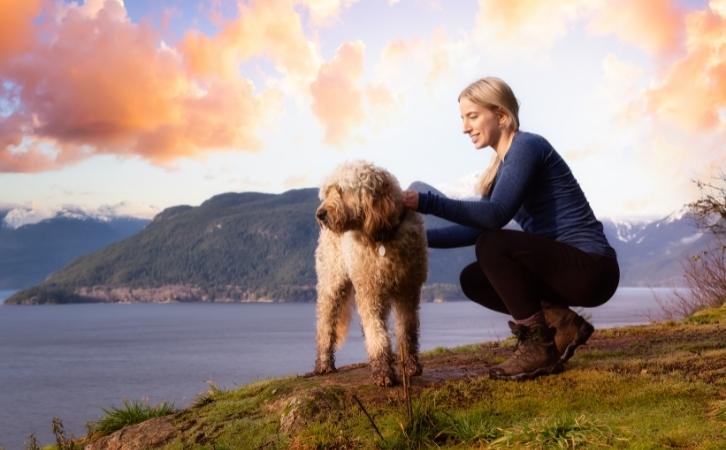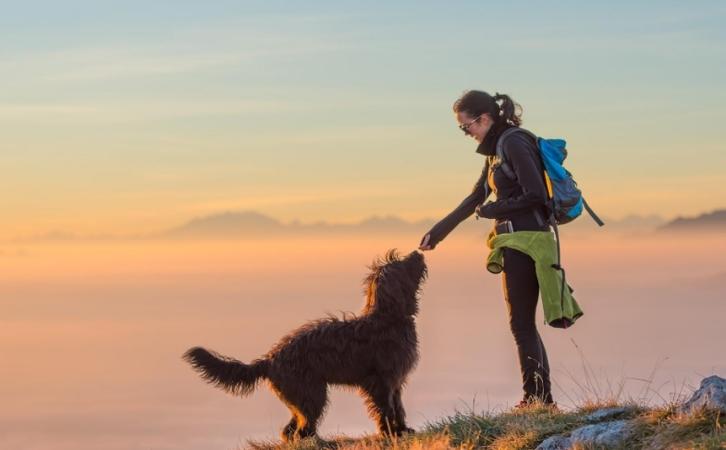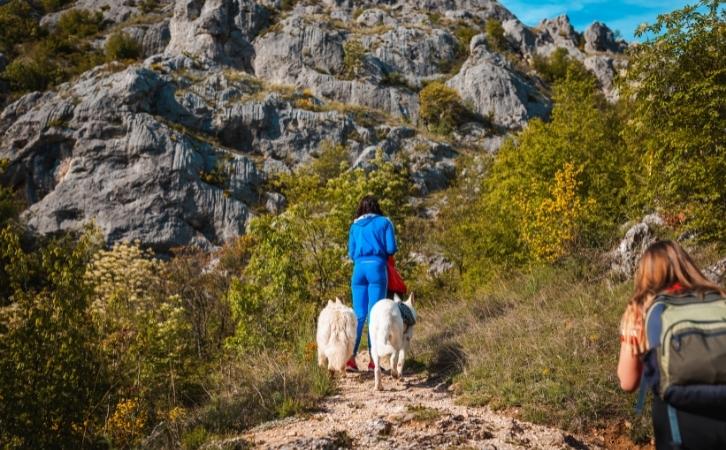Are you planning to kike with your dog?
Hiking with a dog might be one of life’s most gratifying experiences. But if you’re not prepared, so many things can go wrong, and if it’s your first time hiking with dogs, it might be terrifying! You’re now responsible not only for yourself but also for your pet.
Dogs, like people, require preparation before embarking on a hike. And, because they’re dogs, it’s up to their owners to keep them safe and healthy on the trails. Here’s what you should know before going on a hike with your dog:
Read Here: 6 Things To Stop Aggressive Puppy Biting
Table of Contents
Why Should You Hike With Your Dogs?
Some may wonder how hiking with your pets might enhance your vacation experience. We’ve discovered that getting out on the path is a fantastic way to enjoy the outdoors, admire sights that aren’t seen from a car, and get some exercise.
You can also meet some wonderful folks – especially if you hike with your dogs! Allowing your dogs to exchange polite greetings provides you time to seek advice from other hikers on additional pet-friendly activities in the vicinity.
Things You Should Know Before You Go Hiking with Your Dog
1. Select the appropriate trail

Start your dog on easy trails and work your way up to steeper and longer treks, just as you would with human hikers. You’ll know what your dog can do and its fitness level. Smaller dogs may be unable to walk for more than a mile, but energetic young dogs should have no trouble joining you. If you don’t want to carry your dog back to the trailhead, judge your dog carefully.
You must also ensure that the path you chose is dog friendly and that you know the trail’s leash rules. Most metropolitan parks and locations require dogs to be on leashes. However, trails in more isolated areas often need your dog to be under voice control; you may expect largely off-leash pups on these trails.
Check the trail’s laws and regulations before bringing your dog along. Most national parks in the United States, for example, do not allow dogs on the trails, even if they are on a leash. Because state and local park systems differ, it’s always a good idea to plan ahead. Dogs must be leashed at all times in most parks.
Read Here: 7 Ways to Enforce Positive Behavior in Your Dog
2. Get Your Dog Ready for the Trails
Going on a practice hike with your dog is recommended if they have never hiked before. Your dog must walk effectively on a leash and get along with other people and animals on the trail.
Begin with short walks and gradually increase the length of your walks. As they gain endurance, keep an eye on their energy levels on flat ground and progress to more challenging terrain. If your dog does well on an hour-long hike, gradually increase the time to strengthen their stamina. Short-day treks with dogs are next, followed by longer hikes.
When you’re out on the trail with your dog, your dog must obey you. For dogs, this can be difficult, especially when they are enthusiastic about new sights and smells. While on shorter and more extended outings, practice having them sit, stay, and listen. While you’re out, get your dog used to being around you at all times.
Read Here: How to Choose the Right Toys for Your Dog?
3. Make an appointment with your veterinarian

Before taking your dog out on the trail, make an appointment with your veterinarian. Your dog should be physically fit enough to go hiking for the day. When making this selection, age, size, and development can play a role. This is also an excellent opportunity to get your dog’s immunizations up to date, have him microchipped, and acquire any preventative meds he may require.
Depending on your dog’s breed, age, size, and health, your vet may also recommend various trekking durations, distances, and difficulties. Some species are better than others when it comes to trekking. Hiking with little dogs, for example, necessitates shorter and less strenuous hikes. In general, the finest hiking companions are athletic, herding, and working dogs.
4. Food and water should be brought in sufficient quantities

Like you, your dog requires food and drink when hiking. You and your dog will need plenty of fresh, clean water. Because dogs cannot sweat, it is critical to keep them hydrated at all times. Bring snacks to help with your dog’s energy level. They too require calories.
While your dog may go without drinking for lengthy periods, the hot sun might fatigue him. If your dog is overheated, it may not be enough to simply offer it water to drink; you should also pour some over its body to cool it down.
Allowing your dog to drink from streams or lakes should be avoided. These water sources may carry nasty parasites that cause serious gastrointestinal problems in your dog. Having him drink only the water you’ve brought with you could spare you a trip to the vet.
5. Look at the weather report

You might also consider the weather by checking the forecast. Don’t overlook how different elevations, humidity, and sun strength affect you and your dog when traveling. If the temperature is expected to be hot on the day of the hike, make sure there are enough water sources for the dog to drink.
As we previously stated, drinking water isn’t enough; your pet will also need to chill off by taking a bath in cool water if you’re hiking with dogs in the winter. However, consider whether the temperature is too chilly for your dog. While it’s common knowledge that people can suffer from heatstroke, your dog can suffer from it as well if it isn’t properly hydrated and cooled down on a hot day.
6. Prepare a First-Aid Kit for Your Pet
You won’t have immediate access to a veterinarian if you have an accident or injury on the route. It’s critical to have not only a pet-specific first-aid kit on hand but also some basic first-aid knowledge for your pet. Most of the supplies you and your dog will need for cuts, bruises, and abrasions will be found in a human first aid kit.
Wrap wounded paws in compression tape or booties if necessary. Also, after consulting with your veterinarian about the correct dosage, include an antihistamine in case you or your dog is bitten or stung and experiences an allergic response.
7. Take many brakes

Because dogs cannot communicate verbally, you must observe their body language when hiking. Taking frequent pauses is a good idea, especially if you’re just getting started hiking with your partner. When you come to a stop, try to find a shady spot and always provide your dog water.
Make numerous stops along the trail to provide your dog with water and goodies. Keep in mind that dogs are susceptible to heatstroke. Feeding your dog right before or after hiking could make them sick. Feed them 30 minutes before or one hour after your hike.
It’s particularly critical to keep pets safe near water sources. Allowing your dog to swim in or drink from contaminated water can get him sick from parasites or algae in the water. If you’re hiking in a rural place without access to safe, clean water, bring plenty of bottled water or a portable water filter.
8. Allow Your Dog To Help You With The Load

Rather than carrying all the things yourself, give your dog a backpack and let him carry it! Start with lightweight and short walks to acclimate your dog to the pack. When you first begin hiking, make sure to modify the contents of your pack and the straps as needed to maintain a balanced weight distribution. Most dogs can carry up to a third of their body weight safely, so don’t overburden them.
9. Be careful while hiking
The outdoors is full of dangers that might harm you and your canine companion when hiking. Always be cautious and aware of the wildlife and wild flora that surround you. Some animals will harm your dog, while others will avoid you.
You may encounter predators such as bears, cougars, and coyotes, as well as minor risks like snakes, porcupines, and ticks, depending on where and when you go trekking. If you see any wildlife while hiking, make careful to keep your dog near and under control. When it comes to wild plants, some are safe for dogs to come into touch with, while others are poisonous.
10. Clean Up After Your Dog
This is a rule you should adhere to whenever you take your dog to a park, especially when hiking. Dog poo can affect groundwater supplies and natural habitats, not to mention keep other hikers from stepping in it. Clean-up will be easier if you have doggie bags on hand.
Although the majority of dog-friendly paths feature a dog stool station, not all of them have. Check your dog for ticks and fleas when returning to your car or home. If you get these little bugs into your home, or they settle in for the long haul, it’s bad news. Grab your Dog Paw Cleaner and clean the dirt and dirt off your dog’s paws while inspecting for ticks and fleas.
10 things to know before hiking with your dog
reference
10 Things You Should Know Before You Go Hiking with Your Dog


